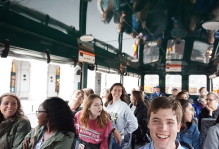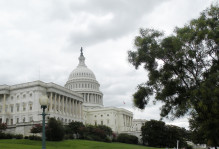A State-Approved, State Department Post
Following accounts of State Department Operations Center and State Department Panel provided by guest bloggers Melanie Gilbert and Ben Kenzer, respectively.
May 14, 2013
We visited the Department of State the same day we went to Health and Human Services; but I didn’t write about them in the same blog because I have absolutely no concept of space and time. Just kidding! Actually, the following information had to be approved by State Department officials, which took a while; but makes this blog even cooler, in my opinion. Prepare yourselves for a state-approved, internationally-accepted piece of writing … if you can.
At the State Department, we had the incredible opportunity to learn first-hand about how the Operations Center of the Department of State functions thanks to Alexis Sullivan ‘04 and James Jay. A 2011 video made for the Operation Center’s 50th anniversary showed us footage of how employees handle calls on a daily basis, which could be from US citizens, foreign leaders, U2’s Bono, or the Secretary of State himself. When a crisis hits, this 24/7 team is there to gather and disperse information to the necessary people as quickly as possible. This team is pulled from the best and brightest in the Department and its members are from a variety of backgrounds. After this site visit, it was obvious that working for the Operations Center is definitely challenging, but important because this unit is crucial to the State Department and allows the United States to enact necessary national security policies. Alexis even shared that she was in the “quarterback” seat of running the Ops Center when several important events have occurred.
After learning about the Operations Center, we experienced a wonderful presentation from a State Department panel organized by the Chief of Staff of the Bureau of Educational and Cultural Affairs, Sarah King with Adnan Kifayat, Deputy Special Representative to Muslim Communities, Heather Lanigan, Office of Middle East Transitions, and Jason Starr ’06, Iran Officer in the Bureau of Democracy, Human Rights, and Labor. Around the Secretary of State’s conference table, the panel discussed the impressive cultural exchange programs organized through the Department of State that include nearly 100,000 participants each year, as well as the important global connections the US fosters via public diplomacy. We at the W&M DCSI were particularly interested in State Department policies on the “frontier” of public diplomacy—programs that seek to engage with the public in nations such as Iran and Venezuela. The panel was candid, enlightening, and extremely insightful towards the W&M DCSI’s goal to elucidate the complex inner workings of US security policy.
I’ve wanted to work at the State Department since I graduated high school. Unfortunately, the competition is proving a bit too competitive and I have yet to be an intern there. However, visiting the site actually made me feel better, as I felt as though I have something to aspire to. Maybe one day I’ll be running around the Operations Center, struggling to give assistance to a distressed diplomat – or maybe I’ll be meeting with fellow State Department officials, procuring some kind of plan to reduce the Iranian threat. Even if I never end up at State, I can at least say I’ve been behind-the-scenes and greatly respect the work that this institution does. It’s extremely important that we emphasize culture, language, and history when dealing with others – and I can say for sure that the Department of State incorporates all three factors (and more) in the context of their foreign relations. All the better for us!



No comments.
Comments are currently closed. Comments are closed on all posts older than one year, and for those in our archive.